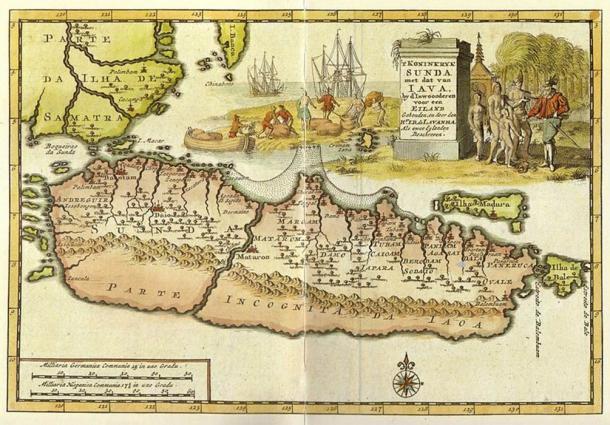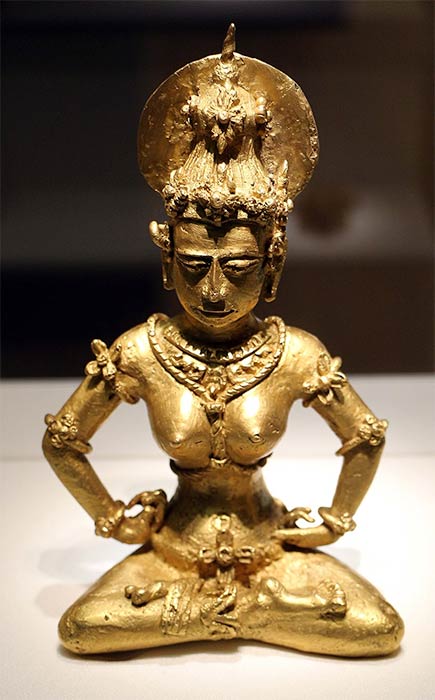The modern-day Java Island of Indonesia now boasts diverse ethnic and religious communities, but the island was once divided by the bitter Battle of Bubat, when a royal wedding turned into a blood bath. The island is traditionally dominated by two of the nation’s largest ethnic groups, the Javanese and the Sundanese, who represent 41 and 15.5 percent of the total population of Indonesia respectively. Many Javanese settle in the central and eastern part of Java, while the western part of Java is known as the Sundanese-dominated Tanah Sunda (Sunda’s land). Although they share the same island, the Sundanese have a different language, traditional writing system and culture from the Javanese.

Old map of Java showing the land of Sunda in the west, separated from the rest of Java island. Here the capital of Sunda is called Daio which refer to Dayeuh Pakuan Pajajaran ( Public Domain)
The Over Ambitious Prime Minister
The Majapahit Kingdom, which existed in Southeast Asia from 1293 until about 1517, was a thalassocratic Javanese Hindu-Buddhist kingdom. During the era of King Hayam Wuruk who ruled from 1350 to 1389, the kingdom reached its pinnacle of prominence, as his reign was characterized by conquests that spread across Southeast Asia. Hayam Wuruk’s achievements is also attributed to his prime minister, Gajah Mada. The Pararaton (The Book of Kings ) records that during his inauguration ceremony as the prime minister of Majapahit in 1334, Gajah Mada famously took an oath not to consume any spiced food until he had conquered the entire archipelago. He reportedly declared: “ Lamun huwus kalah nusantara isun amukti palapa, lamun kalah ring Gurun, ring Seran, Tañjung Pura, ring Haru, ring Pahang, Dompo, ring Bali, Sunda, Palembang, Tumasik, samana isun amukti palapa” (“ If I succeed in defeating Nusantara (Archipelago), then I will break my fast. If Gurun, Seram, Tanjung Pura, Haru, Pahang, Dompo, Bali, Sunda, Palembang, Tumasik, are all defeated, then I will break my fas t”).

21-karat Majapahit period gold image discovered in Agusan, Philippines, copied Nganjuk bronze images of the early Majapahit period signifies the Majapahit cultural influence on southern Philippines. ( Sailko / CC BY-SA 3.0 )
In 1357, King Hayam Wuruk proposed marriage to Dyah Pitaloka Citaresmi, a Sundanese princess. Her father Sunda King Lingga Buana gave his blessings and, accompanied by his queen and ministers, he travelled with his daughter to Trowulan, the capital of Majapahit, for her marriage to Majapahit ‘s king.
Like this Preview and want to read on? You can! JOIN US THERE ( with easy, instant access ) and see what you’re missing!! All Premium articles are available in full, with immediate access.
For the price of a cup of coffee, you get this and all the other great benefits at Ancient Origins Premium. And – each time you support AO Premium, you support independent thought and writing.
Martini Fisher is an Ancient Historian and author of many books, including ”Time Maps: Gods, Kings and Prophets” | Check out MartiniFisher.com
Top Image: The Sati of Ramabai, Wife of Madhavrao Peshwa (reigned 1761-1772) ( Public Domain )
 RSS Feed
RSS Feed















 August 11th, 2020
August 11th, 2020  Awake Goy
Awake Goy  Posted in
Posted in  Tags:
Tags: 













